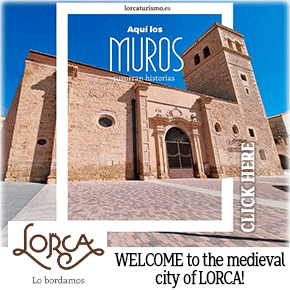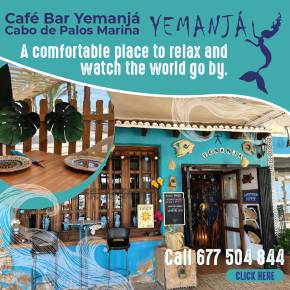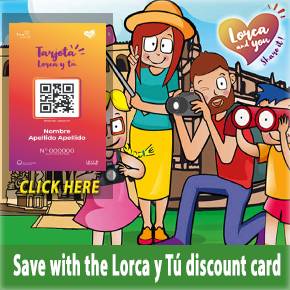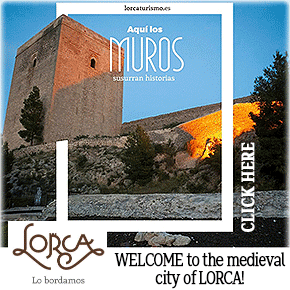January 17 The Cross and The Sword, a free guided tour in Caravaca
In the city of Caravaca de la Cruz the threads of religious belief and military strength are inextricably intertwined
 The history of the Holy City of Caravaca is characterized by two main elements: the presence of the Vera Cruz, believed by many to be a fragment of the cross on which Christ was crucified, and its importance as a frontier city between the 13th and the 15th centuries, when the Region of Murcia was ruled by the Christian kingdoms of Castilla and Aragón but the neighbouring area of Andalucía was still part of the Moorish kingdom of Al-Nazrid.
The history of the Holy City of Caravaca is characterized by two main elements: the presence of the Vera Cruz, believed by many to be a fragment of the cross on which Christ was crucified, and its importance as a frontier city between the 13th and the 15th centuries, when the Region of Murcia was ruled by the Christian kingdoms of Castilla and Aragón but the neighbouring area of Andalucía was still part of the Moorish kingdom of Al-Nazrid.
This can still be seen in the 21st century, for example in the buildings at the top of the hill, where the Basilica of the True Cross is combined with the castle - in fact, this mixture of war and religion can still be heard when locals say that they are going to Mass “in the castle”!
This guided tour on Friday 17th January (given in Spanish, although tour guides generally speak English) explains this historical dual nature of the city, outlining the importance of military-religious orders over the century on a route which includes the Basilica of the True Cross and others of the many religious and military buildings in Caravaca, dating from the Middle Ages to the Baroque period.
The free tour begins at 11.00 with previous online registration required here and participants are advised to wear comfortable walking clothes.
Further information about Caravaca and its role as a Holy City is available from the tourist office (Plaza de España, 7, telephone 968 702424, email turismo@caravacadelacruz.es).
Or for more local information including news and what’s on, go to the home page of Caravaca Today.
Oficina de Turismo de Caravaca de la Cruz
 More information about the places of interest which can be visited in the municipality of Caravaca de la Cruz, along with what's on and local news can be found in the Caravaca Today.
More information about the places of interest which can be visited in the municipality of Caravaca de la Cruz, along with what's on and local news can be found in the Caravaca Today.
Caravaca de la Cruz, in the north-west of the Region of Murcia, is one of only 5 Holy Cities in the Roman Catholic world, a centre of pilgrimage, along with Rome, Jerusalem, Santiago de Compostela and Santo Toribio de Liebana, and is home to the Cross of Caravaca, the Vera Cruz.
The status of Holy City was bestowed by Pope John Paul II in 1998, granting the City a Permanent Jubilee year every 7 years for perpetuity, the first one held in 2003 and the next in 2024.

The strategic and natural advantages of Caravaca de la Cruz have attracted the attention of settlers for more than 800,000 years, the Cueva Negra yielding remains of Homo Heidelbergensis, forbears of the Neanderthals and the municipality also houses important archaeological remains from the Argaric, Iberian and Roman cultures. many of these can be seen in the Municipal Archaeological Museum.
 As a border town caught between the Catholic forces of Castille and the last remaining Moorish stronghold in Spain, Granada, Caravaca had a turbulent medieval history, but it was during this period that the legend of the Cross of Caravaca was born, bringing the religious orders which shaped the structure of Caravaca today, with its impressive hilltop castle and eclectic collection of churches and monasteries, religious tourism today being a backbone of the town´s economy.
As a border town caught between the Catholic forces of Castille and the last remaining Moorish stronghold in Spain, Granada, Caravaca had a turbulent medieval history, but it was during this period that the legend of the Cross of Caravaca was born, bringing the religious orders which shaped the structure of Caravaca today, with its impressive hilltop castle and eclectic collection of churches and monasteries, religious tourism today being a backbone of the town´s economy.
Caravaca de la Cruz is a municipality with important natural resources, including extensive forests, part of which have protected status due to their wealth of flora and fauna, and due to the abundant water supplies is also a major area for canned fruit production, apricots in particular being an important crop.
 Caravaca is renown for its important May Fiestas, held in honour of the Vera Cruz, which also incorporate the Moors and Christians celebrations and the Running of the Wine Horses.
Caravaca is renown for its important May Fiestas, held in honour of the Vera Cruz, which also incorporate the Moors and Christians celebrations and the Running of the Wine Horses.
Caravaca de la Cruz is also the home of Europe´s largest collection of ethnic instruments at Barranda, the Museo de Música Étnica Barranda and is the location of the Barranda festival de Cuadrillas, which celebrates the Region's ethnic music traditions.
The municipality is home to around 26,000 inhabitants and shares boundaries with Moratalla, Cehegín, Lorca, Puebla de Don Fadrique in the province of Granada and Vélez-Blanco in the province of Almería.
Opening times:
Weekdays: 10.00 to 14.00 and 16.30 to 19.30
Saturdays: 10.30 to 14.00 and 16.30 to 19.30
Sundays and public holidays: 10.30 to 14.00
Click for map, Caravaca de la Cruz Tourist Office
































